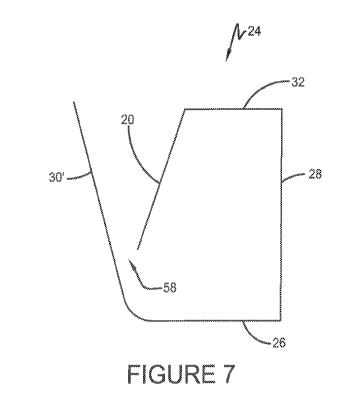Some of the information on this Web page has been provided by external sources. The Government of Canada is not responsible for the accuracy, reliability or currency of the information supplied by external sources. Users wishing to rely upon this information should consult directly with the source of the information. Content provided by external sources is not subject to official languages, privacy and accessibility requirements.
Any discrepancies in the text and image of the Claims and Abstract are due to differing posting times. Text of the Claims and Abstract are posted:
| (12) Patent: | (11) CA 2973859 |
|---|---|
| (54) English Title: | SPRAY BAR DEFLECTION TRAY |
| (54) French Title: | PLATEAU DE DEVIATION DE RAMPE DE PULVERISATION |
| Status: | Granted |
| (51) International Patent Classification (IPC): |
|
|---|---|
| (72) Inventors : |
|
| (73) Owners : |
|
| (71) Applicants : |
|
| (74) Agent: | SMART & BIGGAR LP |
| (74) Associate agent: | |
| (45) Issued: | 2018-10-09 |
| (86) PCT Filing Date: | 2016-01-12 |
| (87) Open to Public Inspection: | 2016-07-21 |
| Examination requested: | 2017-07-10 |
| Availability of licence: | N/A |
| (25) Language of filing: | English |
| Patent Cooperation Treaty (PCT): | Yes |
|---|---|
| (86) PCT Filing Number: | PCT/US2016/013064 |
| (87) International Publication Number: | WO2016/115146 |
| (85) National Entry: | 2017-07-10 |
| (30) Application Priority Data: | |||||||||
|---|---|---|---|---|---|---|---|---|---|
|
A spray trough is described herein, includ-
ing a trough body, wherein the trough body has a bottom
portion, a first side portion, a second side portion, a front
portion, and a back portion, the bottom portion, the front
portion, and the back portion each having a first end and
a second end, a top plate having a first end and a second
end, wherein the first end of the top plate is fixedly at-
tached to the second end of the back portion, wherein the
top plate extends substantially perpendicular from the
second end of the back portion, and a deflector plate,
wherein the deflector plate is attached to the second end
of the front plate, wherein the deflector plate extends
downwardly from the second end of the front plate, such
that the deflector plate angles towards the front portion.
La présente invention concerne une auge de pulvérisation qui comprend un corps d'auge, le corps d'auge ayant une partie inférieure, une première partie latérale, une seconde partie latérale, une partie avant, et une partie arrière, la partie inférieure, la partie avant et la partie arrière ayant chacune une première extrémité et une seconde extrémité, une plaque supérieure ayant une première extrémité et une seconde extrémité, la première extrémité de la plaque supérieure étant fermement fixée à la seconde extrémité de la partie arrière, la plaque supérieure s'étendant sensiblement d'une manière perpendiculaire à partir de la seconde extrémité de la partie arrière, et une plaque de déviation, la plaque de déviation étant fixée à la seconde extrémité de la plaque avant, la plaque de déviation s'étendant vers le bas à partir de la seconde extrémité de la plaque avant, de telle sorte que la plaque de déviation s'incline vers la partie avant.
Note: Claims are shown in the official language in which they were submitted.
Note: Descriptions are shown in the official language in which they were submitted.

For a clearer understanding of the status of the application/patent presented on this page, the site Disclaimer , as well as the definitions for Patent , Administrative Status , Maintenance Fee and Payment History should be consulted.
| Title | Date |
|---|---|
| Forecasted Issue Date | 2018-10-09 |
| (86) PCT Filing Date | 2016-01-12 |
| (87) PCT Publication Date | 2016-07-21 |
| (85) National Entry | 2017-07-10 |
| Examination Requested | 2017-07-10 |
| (45) Issued | 2018-10-09 |
There is no abandonment history.
Last Payment of $210.51 was received on 2023-10-13
Upcoming maintenance fee amounts
| Description | Date | Amount |
|---|---|---|
| Next Payment if small entity fee | 2025-01-13 | $100.00 |
| Next Payment if standard fee | 2025-01-13 | $277.00 |
Note : If the full payment has not been received on or before the date indicated, a further fee may be required which may be one of the following
Patent fees are adjusted on the 1st of January every year. The amounts above are the current amounts if received by December 31 of the current year.
Please refer to the CIPO
Patent Fees
web page to see all current fee amounts.
| Fee Type | Anniversary Year | Due Date | Amount Paid | Paid Date |
|---|---|---|---|---|
| Request for Examination | $800.00 | 2017-07-10 | ||
| Application Fee | $400.00 | 2017-07-10 | ||
| Maintenance Fee - Application - New Act | 2 | 2018-01-12 | $100.00 | 2017-07-10 |
| Final Fee | $300.00 | 2018-08-27 | ||
| Maintenance Fee - Patent - New Act | 3 | 2019-01-14 | $100.00 | 2019-01-07 |
| Maintenance Fee - Patent - New Act | 4 | 2020-01-13 | $100.00 | 2019-12-16 |
| Maintenance Fee - Patent - New Act | 5 | 2021-01-12 | $200.00 | 2020-12-18 |
| Maintenance Fee - Patent - New Act | 6 | 2022-01-12 | $204.00 | 2021-09-29 |
| Maintenance Fee - Patent - New Act | 7 | 2023-01-12 | $203.59 | 2022-10-14 |
| Maintenance Fee - Patent - New Act | 8 | 2024-01-12 | $210.51 | 2023-10-13 |
Note: Records showing the ownership history in alphabetical order.
| Current Owners on Record |
|---|
| MIDWEST INDUSTRIAL SUPPLY, INC. |
| Past Owners on Record |
|---|
| None |